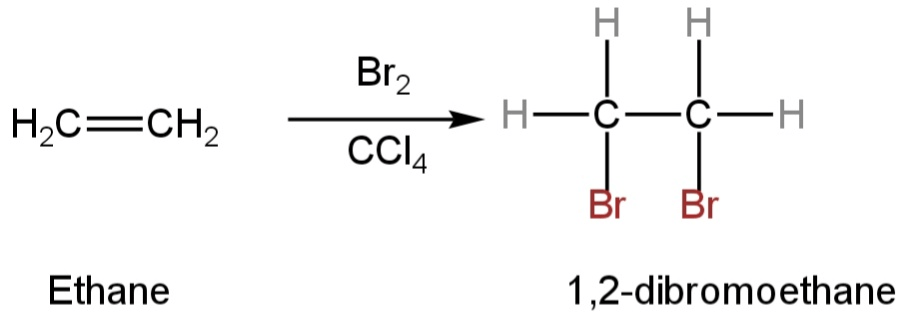
In a reaction, if half of the double bond is broken and two new bonds are formed, this is a case of
A. Elimination
B. Addition
C. Displacement
D. Rearrangement
Answer
220.8k+ views
Hint: Addition reaction is a chemical reaction in which two or more reactants react to form an individual product. Elimination, displacement, or rearrangement reactions do not include the breaking of half of the double bonds and the formation of two new bonds.
Complete Step by Step Solution:
Here in this question, we have to find out a reaction in which half of the double bond is broken and two new bonds are formed.
A. Elimination
Elimination reaction involves the elimination of a couple of atoms or a group of atoms in the presence of a suitable reagent giving rise to unsaturated compounds.
These reactions are utilised to convert saturated compounds to unsaturated compounds.
So, these types of reactions do involve double bonds but lead to the formation of double bonds.
So, A is incorrect.
B. Addition
An addition reaction is a chemical reaction in which two or more reactants react to form an individual product.
Chemical compounds comprising multiple bond characters can undergo these types of reactions.
Double or triple bonds are usually broken down to create single bonds.
It is the opposite of an elimination reaction.
For example, the conversion of ethene to 1,2-dibromoethane.

The double bond is broken and two new bonds are formed.
So, B is correct.
C. Displacement
A displacement reaction or a single replacement reaction is a chemical reaction in which one element is displaced by another in a compound.
It can be depicted as:
\[A + BC \to AC{\rm{ }} + {\rm{ }}B\]
where
A and B are different metals and C is an anion.
Or
A, and B are halogens and C is a cation.
D. Rearrangement
A rearrangement reaction is a category of organic reactions involving the carbon skeleton of a molecule that is rearranged to provide a structural isomer of the actual molecule.
It mainly involves the moving of the substituent from one atom to another atom in one molecule.
So, these reactions are mainly intramolecular.
So, D is incorrect.
So, option B is correct.
Note: Addition reactions are restricted to chemical compounds that possess multiple bonds like molecules with carbon-carbon double bonds or alkenes or with triple bonds or alkynes and compounds that possess rings. Molecules comprising carbon—hetero double bonds, for example, carbonyl (\[{\rm{C = O}}\]) groups, or imine (\[{\rm{C = N}}\]) groups, can go through addition due to double-bond character.
Complete Step by Step Solution:
Here in this question, we have to find out a reaction in which half of the double bond is broken and two new bonds are formed.
A. Elimination
Elimination reaction involves the elimination of a couple of atoms or a group of atoms in the presence of a suitable reagent giving rise to unsaturated compounds.
These reactions are utilised to convert saturated compounds to unsaturated compounds.
So, these types of reactions do involve double bonds but lead to the formation of double bonds.
So, A is incorrect.
B. Addition
An addition reaction is a chemical reaction in which two or more reactants react to form an individual product.
Chemical compounds comprising multiple bond characters can undergo these types of reactions.
Double or triple bonds are usually broken down to create single bonds.
It is the opposite of an elimination reaction.
For example, the conversion of ethene to 1,2-dibromoethane.

The double bond is broken and two new bonds are formed.
So, B is correct.
C. Displacement
A displacement reaction or a single replacement reaction is a chemical reaction in which one element is displaced by another in a compound.
It can be depicted as:
\[A + BC \to AC{\rm{ }} + {\rm{ }}B\]
where
A and B are different metals and C is an anion.
Or
A, and B are halogens and C is a cation.
D. Rearrangement
A rearrangement reaction is a category of organic reactions involving the carbon skeleton of a molecule that is rearranged to provide a structural isomer of the actual molecule.
It mainly involves the moving of the substituent from one atom to another atom in one molecule.
So, these reactions are mainly intramolecular.
So, D is incorrect.
So, option B is correct.
Note: Addition reactions are restricted to chemical compounds that possess multiple bonds like molecules with carbon-carbon double bonds or alkenes or with triple bonds or alkynes and compounds that possess rings. Molecules comprising carbon—hetero double bonds, for example, carbonyl (\[{\rm{C = O}}\]) groups, or imine (\[{\rm{C = N}}\]) groups, can go through addition due to double-bond character.
Recently Updated Pages
Difference Between Alcohol and Phenol: Structure, Tests & Uses

Classification of Drugs in Chemistry: Types, Examples & Exam Guide

Class 12 Chemistry Mock Test Series for JEE Main – Free Online Practice

Is PPh3 a strong ligand class 12 chemistry JEE_Main

Full name of DDT is A 111trichloro22bispchlorophenyl class 12 chemistry JEE_Main

Sodium acetate on heating with soda lime produce A class 12 chemistry JEE_Main

Trending doubts
JEE Main 2026: Application Form Open, Exam Dates, Syllabus, Eligibility & Question Papers

Derivation of Equation of Trajectory Explained for Students

Hybridisation in Chemistry – Concept, Types & Applications

Understanding the Angle of Deviation in a Prism

How to Convert a Galvanometer into an Ammeter or Voltmeter

Degree of Dissociation: Meaning, Formula, Calculation & Uses

Other Pages
Solutions Class 12 Chemistry Chapter 1 CBSE Notes - 2025-26

NCERT Solutions For Class 12 Chemistry Chapter 1 Solutions - 2025-26

The D and F Block Elements Class 12 Chemistry Chapter 4 CBSE Notes - 2025-26

NCERT Solutions for Class 12 Chemistry Chapter Chapter 7 Alcohol Phenol and Ether

NCERT Solutions ForClass 12 Chemistry Chapter Chapter 8 Aldehydes Ketones And Carboxylic Acids

JEE Advanced Marks vs Ranks 2025: Understanding Category-wise Qualifying Marks and Previous Year Cut-offs




